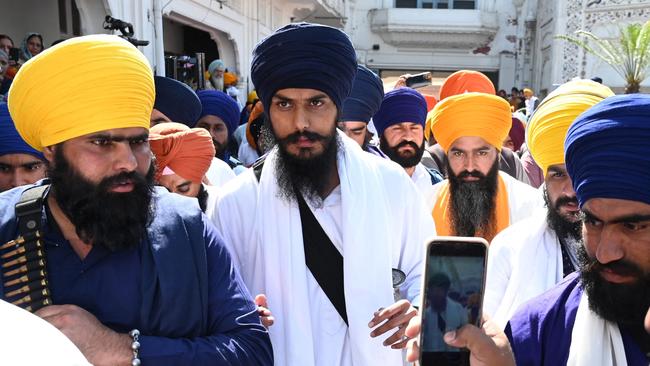Indian cops nab Sikh separatist leader
The month-long manhunt for Amritpal Singh sparked protests among the diaspora in Australia, Britain, Canada and the US.

Indian police on Sunday arrested a Sikh separatist after a manhunt lasting more than a month that sparked protests and vandalism among the diaspora in Australia, Britain, Canada and the US.
Amritpal Singh rose to fame calling for the creation of a separate Sikh homeland known as Khalistan, the struggle for which sparked deadly violence in India in the 1980s and ’90s.
Police arrested Mr Singh about 6.45am, having surrounded a village in the northern state of Punjab following intelligence he was in a gurdwara, or Sikh temple. “Once he got the message that he had no escape route and he was surrounded, he was arrested,” senior police official Sukhchain Singh Gill said.
Mr Singh, 30, styles himself on Jarnail Singh Bhindranwale, a figurehead of the Khalistan movement killed when the Indian army stormed the Golden Temple in Amritsar in 1984.
He sports a similarly styled blue turban and long beard and reportedly travelled to the former Soviet republic of Georgia last year for cosmetic surgery to look more like his hero.
Mr Singh and his supporters, armed with swords, knives and guns, raided a police station in February after one of the preacher’s aides was arrested for assault and attempted kidnapping.
Authorities then tried to arrest Mr Singh, but he escaped, reportedly on a motorbike after changing clothes at a gurdwara. Deploying thousands of officers in the manhunt, authorities cut off mobile internet for days in the Sikh-majority northern state of 30 million in their search. They arrested more than 100 of his followers, transferring them to jails hundreds of kilometres away, and banned gatherings of more than four people in some areas.
After reported sightings of Mr Singh in New Delhi and elsewhere, he released a video in late March in which he taunted authorities and called the police operation an “attack on the Sikh community”.
“I was neither afraid of arrest earlier, nor am I now. I am in high spirits. Nobody could harm me. It is the grace of God,” he said.
The operation sparked protests by Sikhs outside Indian consulates in Melbourne, Britain, Canada and the US.
Demonstrators smashed windows in San Francisco, took down an Indian flag at the Indian high commission in London and reportedly vandalised a Gandhi statue in Ontario.
India summoned top US, British and Canadian diplomats to complain and press for improved security at Indian missions in their countries.
Mr Singh’s video was posted on Twitter accounts based in Britain and Canada, which the social media company took down in India following government requests. Twitter also blocked for Indian users the accounts of several prominent Sikh Canadians who criticised the crackdown, including MP Jagmeet Singh, as well as several journalists.
Punjab, which is about 58 per cent Sikh and 39 per cent Hindu, was rocked by a violent separatist movement for Khalistan in the ’80s and early ’90s in which thousands of people died. The botched 1984 raid in Amritsar, known as Operation Blue Star, led to the assassination of prime minister Indira Gandhi by her Sikh security guards a few months later. That in turn sparked an anti-Sikh pogrom that left thousands more people shot and burned to death.
AFP



To join the conversation, please log in. Don't have an account? Register
Join the conversation, you are commenting as Logout